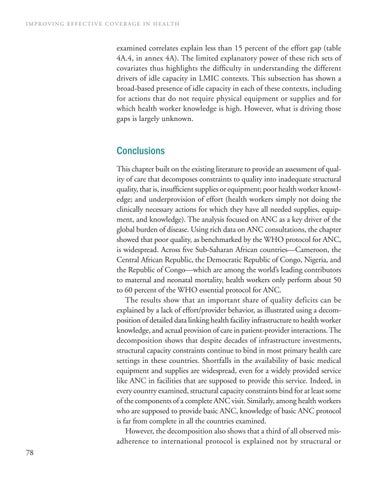IMPROVING EFFECTIVE COVERAGE IN HEALTH
examined correlates explain less than 15 percent of the effort gap (table 4A.4, in annex 4A). The limited explanatory power of these rich sets of covariates thus highlights the difficulty in understanding the different drivers of idle capacity in LMIC contexts. This subsection has shown a broad-based presence of idle capacity in each of these contexts, including for actions that do not require physical equipment or supplies and for which health worker knowledge is high. However, what is driving those gaps is largely unknown.
Conclusions This chapter built on the existing literature to provide an assessment of quality of care that decomposes constraints to quality into inadequate structural quality, that is, insufficient supplies or equipment; poor health worker knowledge; and underprovision of effort (health workers simply not doing the clinically necessary actions for which they have all needed supplies, equipment, and knowledge). The analysis focused on ANC as a key driver of the global burden of disease. Using rich data on ANC consultations, the chapter showed that poor quality, as benchmarked by the WHO protocol for ANC, is widespread. Across five Sub-Saharan African countries—Cameroon, the Central African Republic, the Democratic Republic of Congo, Nigeria, and the Republic of Congo—which are among the world’s leading contributors to maternal and neonatal mortality, health workers only perform about 50 to 60 percent of the WHO essential protocol for ANC. The results show that an important share of quality deficits can be explained by a lack of effort/provider behavior, as illustrated using a decomposition of detailed data linking health facility infrastructure to health worker knowledge, and actual provision of care in patient-provider interactions. The decomposition shows that despite decades of infrastructure investments, structural capacity constraints continue to bind in most primary health care settings in these countries. Shortfalls in the availability of basic medical equipment and supplies are widespread, even for a widely provided service like ANC in facilities that are supposed to provide this service. Indeed, in every country examined, structural capacity constraints bind for at least some of the components of a complete ANC visit. Similarly, among health workers who are supposed to provide basic ANC, knowledge of basic ANC protocol is far from complete in all the countries examined. However, the decomposition also shows that a third of all observed misadherence to international protocol is explained not by structural or 78

